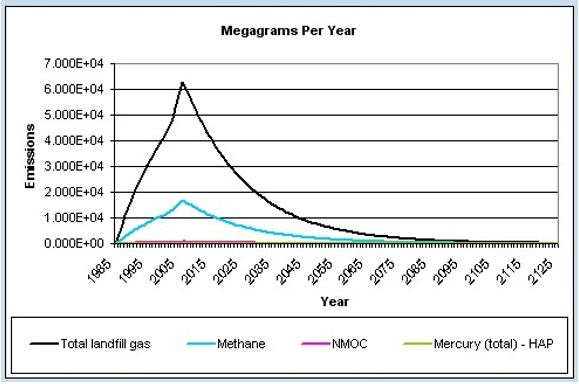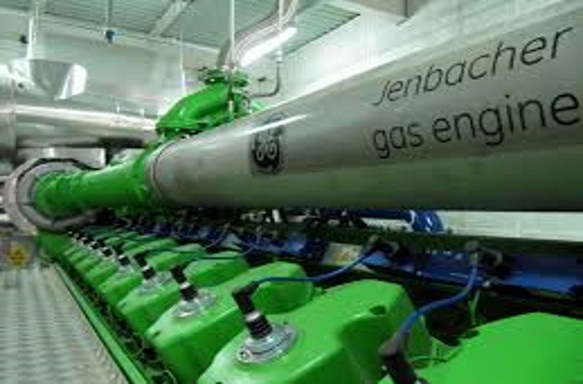Using Landfill Gas for Energy Surety Microgrids

Landfill gas (LFG) is a natural byproduct of the decomposition of organics in landfills. LFG is comprised of roughly 50 percent methane (the primary component of natural gas) and 50 percent carbon dioxide (CO2). Methane is a powerful greenhouse gas with 30 times the capacity of CO2 to trap heat in the atmosphere. Landfill gas is produced by microorganisms that generate the gas in three phases: 1) CO2 is produced under aerobic conditions, 2) once oxygen is depleted, CO2 and hydrogen H2 are produced under anaerobic conditions, and 3) CO2 production then depletes in proportion to the CH4 that is produced. The chart above illustrates typical concentrations occurring over the lifespan of a landfill. Finally, significant LFG production typically begins one or two years following waste disposal in a landfill and can continue for 10 to 60 years or longer.
Municipal solid waste (MSW) landfills generate a tremendous amount of methane and are the third-largest source of human-related methane emissions in the United States, accounting for over 14 percent of total emissions. These emissions provide a tremendous opportunity to effectively utilize and eliminate a problematic waste stream by turning it into a valuable energy resource.
Variables and events that create outages for natural gas are largely independent of those that could disrupt the flow of LFG, making LFG an independent and non-coincidental energy source with natural gas. Utilizing these energy storage reserves as part of a diversified energy portfolio for an energy surety microgrid improves energy resiliency and sustainability.
Blackstart Capability for Critical Loads
Normally, the electric power used within a generation plant is provided from the station’s own generators. If all of the plant’s main generators are shut down, station service power is provided by drawing power from the grid through the plant’s transmission line.
However, during a wide-area outage, power from the grid is not available. In the absence of grid power, a so-called “black start” needs to be performed to bootstrap the power generation system into operation.
To provide black starts, some power stations have small diesel generators or arrays of batteries to provide starting current in the event of a grid outage.
Since landfill gas supply for many sites is completely independent of the supply of natural gas, LFG generators designed for microgrid islanding with black start capability can provide both thermal and electrical energy to a critical load in the complete absence of grid power or natural gas being available.

Natural gas reciprocating engines used for distributed energy production require a small amount of parasitic load for auxiliaries and energy for black starts. By comparison, generating plants using steam turbines require station service power of up to 10% of their capacity for boiler feedwater pumps, boiler forced-draft combustion air blowers, and for fuel preparation. This makes gas-fired reciprocating engines an ideal choice for islanding scenarios since they require minimal initial power to start – just enough to turn the engine and provide excitation current to the generator field coils – and can put a large block of power on line very quickly.
Multi-Fuel / Multi-Unit / Multi-System
Utilizing “Smart Redundancy” for microgrids involves taking a system-wide probabilistic approach to determining resiliency rather than the typical fallback method of simply applying “N+1” to certain systems. Oftentimes, system availabilities can be enhanced more economically by diversifying fuel sources and generator types than by simply installing more equipment.
PowerSurety employs an empirical approach to determine likely availabilities using probabilistic risk assessments (PRAs) and other tools to optimize capital and long term operating costs based system uptime and availability requirements. As an example, an LFGE CHP plant designed with auxiliary boilers to supplement existing sources and utilize both LFG and natural gas as part of a fuel utilization strategy would be able to provide the following:
-
Thermal energy from any combination of two different fuels from three different generator types from two different locations.
This level of diversification opens the door for many different generation scenarios and increases the probability that thermal generation will take place for the myriad of upset conditions that would interrupt a simple N+1 approach.
Smart Redundancies for Energy Surety Microgrids

| Variable | Value | Description |
|---|---|---|
| n | 5 | Number of Thermal Energy Generators |
| r | 2 | Number of Allowable Failures |
| p | 0.85 | Probability of Individual Generator Availability |
| q | 0.15 | Probability of Individual Generator Failure |
| x | Number of Available Thermal Generators | |
| P(S) | Probability of Thermal Energy Available for Critical Loads |
LFGE CHP plants represent an excellent opportunity to leverage an environmentally sound fuel supply to displace utility electrical and thermal energy. Overlaying a microgrid strategy with long-term islanding capabilities on top of this approach represents an ideal strategy for facilities in need of power surety and energy resiliency. In order for these strategies to be economical, a paradigm shift is required during the development process to include smart redundancies early in the design process when the ability to shape outcomes is at its highest. PowerSurety utilizes our most senior staff early-on in the development process to maximize this window of opportunity


